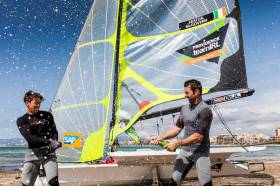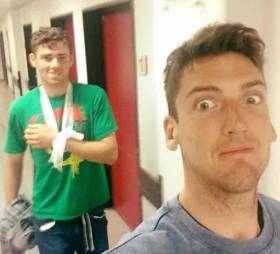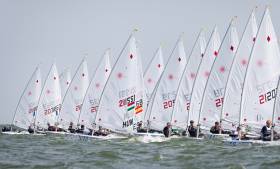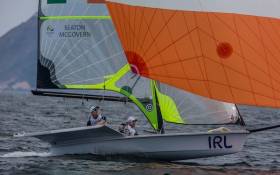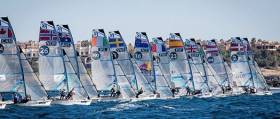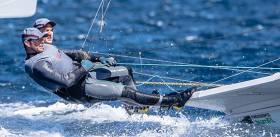Displaying items by tag: Matt McGovern
Foiling Ballyholme Waszp Dinghy Duo Sail to Scotland and Back to Raise Funds for Jodi’s Giants Charity
The North Channel isn’t a very enticing place when you want to sail to Portpatrick on the Mull of Galloway in Scotland in windy conditions in a hydrofoiling Waszp dinghy and even less so when you’re attempting to set a Guinness World Record.
So Matt McGovern and Bob Espey from Ballyholme Yacht Club on Belfast Lough had to postpone their first attempt to do just that in a fundraiser for Jodi’s Giants, a group set up to raise money for children’s cancer charities. The focus of this attempt is the Tomalin family whose little boy Jodi was diagnosed with cancer last year.
Speaking to Belfast Live, Jodi's parents said: "Only Bob and Matt could come up with this idea! It will be some laugh watching how wet they get. We can't wait”.
The first attempt on 12th June was scuppered by strong winds and big seas but on the evening of 16th June, the boys were successful and made it the twenty-two miles to Portpatrick and back by midnight.
Bob has been a long-time sailing competitor at Ballyholme, having raced Lasers, 49ers and RS 400s. Matt represented Ireland at the 2012 Summer Olympics in the 49er class alongside Ryan Seaton, finishing 14th. He participated in the 2016 Summer Olympics in Rio as well.
On last Thursday evening, Matt and Bob set off with little warning in a perfect 12 -14 knot southerly breeze and arrived just off Portpatrick Harbour in 1 hour 30mins.
Matt said he is not sure if it will be accepted as a Guinness Record, but they do have a GPS record of the trip.
 A view of Donaghadee from a foiling Waszp dinghy
A view of Donaghadee from a foiling Waszp dinghy
But those who know the North Channel, are aware of its vagaries and unfortunately, the steady breeze didn’t last. And, as the wind and waves built, they had 18 knots with more at times and capsized frequently.
Then that was followed by no wind at all and a strong tide near the Copeland Islands off the North Down coast. So, it was a midnight finish after a 3 hours 23 mins crossing.
 Bob Espey (left) with Matt McGovern and their families before the charity sail to Scotland
Bob Espey (left) with Matt McGovern and their families before the charity sail to Scotland
Safety cover was provided by Safer Waters, a charity which provided safety cover for community events.
Matt McGovern Rejoins Irish Sailing Team As 49er Coach
Former Irish Olympic 49er sailor Matt McGovern has rejoined the Irish Sailing team as coach in the two-handed skiff class.
McGovern, who represented Ireland in the 49er at London 2012 and Rio 2016 with Ryan Seaton, retired from active competition in February last year and subsequently took up the role of high performance manager with the RYANI.
He will now assume coaching responsibilities for the two Irish Sailing 49er teams, which include his former skiff partner Seaton’s duo with Seafra Guilfoyle. The pair placed sixth in the World Cup medal race at Enoshima, the site for next summer’s Olympics, this past August.
Robert Dickson and Sean Waddilove, 2018 U23 49er World Champions and Volvo Irish Sailors of the Year, will also benefit from McGovern’s Olympic experience.
Irish Sailing head coach Rory Fitzpatrick said: “It’s great to have Matt join the coaching team. An accomplished athlete, he’ll bring a wealth of experience to the whole team. He is also one of the most organised and prepared athletes.
“In our Performance HQ we have a picture of him and Ryan in the workshop — it’s placed there as a reminder of Matt’s attention to detail, and something we want to inspire the younger athletes with.”
McGovern joins the team ahead of Ireland’s next bid for a place at Tokyo 2020 in the 49er Worlds this December.
49er Sailor Matt McGovern Announces Olympic Retirement
Two time Sailing Olympian Matt McGovern (34) from Belfast Lough has abandoned plans for his third sailing Olympics at Tokyo 2020 and announced his retirement.
Teamed with Carrickfergus helmsman Ryan Seaton for London and Rio, the pair became Ireland’s most successful skiff duo in the Olympic 49er dinghy.
The Northern Ireland pair split after 2016 and shortly after both announced separate campaigns for Tokyo. In January last year, McGovern launched a 49er campaign with 2013 Laser youth champion Robbie Gilmore and the pair spent 2017 on the international circuit. Four Irish 49er campaigns were competing for the single place in Tokyo last season.
From 2009 to 2016, Seaton and McGovern counted World Cup medals, European regatta wins and Olympic race wins in London 2012 as well as making the Olympic medal race final in Rio 2016.
James O’Callaghan Irish Sailing’s Performance Director adds: “From day one Matt was a bundle of energy and enthusiasm. Eighteen years on, no change. His approach, results and outlook are an excellent guide to the next generation".
There has been a set back for Northern Ireland's Ryan Seaton and his new crew Seafra Guilfoyle of Royal Cork Yacht Club at their first world championships in the 49er class.
Guilfoyle had a bike accident on the eve of the Portuguese event and attended hospital in Porto for a hand injury ruling him out of the championships. After six months of hard work training for the event – and the stated aim of Gold in Tokyo 2020 – Carrickfergus Sailing Club's Seaton has opted to sail instead with the team coach, Nikolaus Resch.
Irish Results
This new impromptu combination are lying in 22 place in the 81–boat event, well ahead of the next of five Irish boats, Sean and Tadgh Donnelly of the National Yacht Club who are in 54th place. Next is Robert Dickson and Sean Waddilove in 60th with Matthew McGovern and Robert Gilmore 64th. Mark Hassett and Oisin Driscoll are 73rd and Cian Byrne and Patrick Crosbie are 75th.
Afloat in Porto, Capsizes, gear failures, and even seasickness beat up numerous crews, but none of it fazed newly crowned European Champions Dylan Fletcher and Stu Bithell at all. The British Olympic skipper and his new-for-2017 crew (a former Olympic medalist in the 470 Class) couldn’t put a foot wrong today, taking all three races on the Alpha course and carrying a four-point lead into the Gold Fleet action tomorrow morning.
It was moving day for Diego Botin and Iago Lopez, the young Spanish duo notching a 2,3,5 score to overcome yesterday’s UFD and move into second place overall – their best ever current position at a Worlds. For Botin the position is good but he knows it doesn’t mean much, especially with two boats tied with them on points. “Everything will be decided tomorrow and Saturday, we’re basically starting over now,” said Botin, who nearly threw away Race 5 with a capsize at the top mark. “I dropped the tiller at the last tack at the top mark so we flipped, but we were lucky the wind was so strong and so many of the other boats had problems,” said Botin. Lopez explained that the runs were extremely tough to handle; “The waves were nasty downwind, requiring big eases of the gennaker every five seconds or so,” he said. “Also finding a flat spot for the gybe was rare, and that’s why you saw so many teams overstanding the bottom marks.”
The strong German sailors we wrote about yesterday continued to excel in the big breeze, with two veteran and two youth teams advancing to Gold Fleet at the end of the day – double the number of any other nation. While the success of Schmidt/Boehme (3rd) and Heil/Ploessel (6th) after Day 4 surprised no one, youth sailors everywhere should rejoice to see two young German teams advance to the Worlds Gold Fleet for the first time. Nils Carstensen (22) and Jan Frigge (23) pulled an ultra-consistent 8,7,7 in the ultra-chaotic conditions to take 15th place after 6 races, while Jakob Meggendorfer and Andreas Spranger squeaked through into the semi-final round in the last available position – 20th place.
The 20 and 21 year old phenoms seem to eat big breeze for breakfast – they showed poise and speed far beyond their years in Kiel when the winds came on at the European Championship, and they continued their heavy weather excellence today in Porto despite several capsizes and a major equipment issue. “Strong wind is so fun, but we didn’t expect to be so fast against some of these teams,” said Meggendorfer. And fast they were; the duo recorded some of the highest speeds on the water today, recovering well from their capsizes to advance to the next round. “Our coach says boat speed is king, so even if we have some problems, at least we have that!” said Spranger.
Both Finn Lynch in the Laser and new Northern Ireland 49er combination Matt McGovern and Robbie Gilmore sit in the top ten of the Delta Lloyd Regatta Medemblik, Netherlands that started yesterday. Six Irish sailors into total are competing with great competition across seven classes so far.
Many Olympic sailors raced their first event since Rio. There were also a number of sailors, training here in Medemblik, aiming for Tokyo 2020. The conditions on the water were great, with a nice breeze and plenty of sun.
Also competing from Ireland are Aisling Keller in the Laser Radials, and Cian Byrne and Patrick Crosbie in the 49ers. Results are here.
Focus for the Laser Radial sailors is mostly on the World Championships in Medemblik later this year. It was strong start from Britain's Alison Young, with two first places. It's also the first event back in the boat for gold Olympic medallist and Dutch favourite, Marit Bouwmeester but Ireland's Olympic silver medalist Annalise Murphy is not competing.
German 49er sailors try to stay calm
After the first day of racing we find Tim Fischer and Fabian Graf, team Germany, in the lead. "This event is more training for us. We're in the lead after the first day, which we didn't really expect. It has been a really good day after all. The next few days will probably be trickier. We just have to stay calm, sail well and get a good result to get into the medal race."
The competition in the 49erFX is very close. Croatian, Enia Nincevic, transferred from the 470 women to the 49erFX and is training with Igor Marenic, three time Olympian and gold medallist at the summer Olympics.
Tenth Overall for Seaton & McGovern at 2016 49er Olympic Regatta
Ryan Seaton and Matt McGovern entered the medal race in the Men's 49er today, knowing that medals were out of their reach, but they were looking to cap a fine performance in the preliminary stages with a good medal race result. The New Zealander pairing had been already declared winners before the ultimate race had started, so the fight was for the minor placings. Statistically, only the 4th place Brits could improve into a medal position, leaving 5th to 10th positions to battle it out for bragging rights.
The New Zealand team, with no pressure on them sailed straight into the lead, and, as so often in the past, did not relinquish it until the finish to crown a great series, a great quad and to win the gold in considerable style.
Behind them the Irish gamble on the left side on the 2nd beat didn’t pay off but a British capsize at the bottom mark and some smart sailing up the beat, followed by a gybe set at the final windward mark saw the Irish boat recover to 6th, only to lose three places in the final approach to the finish.
So a 10th overall for Seaton and McGovern, a wonderful result that sets them up for the next four years. They will take great confidence forward, particularly with a series that included two 1sts a 2nd and a 4th.
A better day yesterday for Ireland’s Ryan Seaton and Matt McGovern brought the 49er skiff duo into the top ten when they posted two sixth places for the day, boosting the Northern Ireland pair to ninth overall.
Unfortunately, Ireland’s sailors in the both 49erFX and Laser Radial classes had more disappointing results and they are in the back of their respective classes.
Andrea Brewster and Saskia Tidey stay 14 from 15. In the Laser Radial, Annalise Murphy lies 37 from 39. Howth Yacht Club's Aoife Hopkins moved up to 29th yesterday.
'Tight' and 'light' were the main descriptors used by sailors at Sailing World Cup Weymouth and Portland as challenging conditions continued across the London 2012 Olympic waters.
The light breeze ensured Friday's racing was challenging and tense across the fleets that were able to race in the morning. All fleets came ashore at 13:20 with only the Men's and Women's 470, 49er, Finn and Nacra 17 completing races in the morning session.
At 16:00, the 49erFX, Men's and Women's RS:X, Laser and Laser Radial fleets went out onto the water and all but the 49erFX got some racing in.
It's fair to say the day was a tough one for all of the 330 sailors from 43 nations racing across the ten Olympic fleets. Saturday's schedule sees 33 races on the agenda as the Race Committee look to catch up on lost races.
49er and 49erFX
Dylan Fletcher and Alain Sign (GBR) thrived in the light breeze, snapping up a first and a second from two 49er races. They lead on 17 points and are five clear of Poland's Lukasz Przybytek and Pawel Kolodzinski.
The pair were recently selected to sail for Team GB at the Rio 2016 Olympic Games after a gruelling selection battle. Their ticket to Rio is booked and they're now firmly focused on the competition, "Last year we had some difficult times and we made some changes, but now we are on an upward curve,” explained Fletcher. "We are really finding our feet now in Rio style conditions, which are a bit patchy. They seem to be our favourite conditions and we seem to thrive in them.”
Every athlete heading to the Olympic Games is nearing their peak physical and mental fitness. Weymouth and Portland gives the sailors one last chance to test themselves before the summer showcase.
French Rio representatives Julien d'Ortoli and Noe Delpech have found their feet in Weymouth and Portland and after the Brits took the first race win, they claimed the second.
They sit in fourth overall and are enjoying racing in a competitive 30-boat fleet. "Everybody is sailing well,” explained d'Ortoli, "and they are definitely ready for the Olympics so the competition is tough.
"Our preparation isn't finished and we are here to complete that preparation. We need to work on technique, speed and tactics. We are happy that there are good teams here to test against.”
The French team are ahead of many Rio medal hopefuls such as Jonas Warrer and Christian Peter Lubeck (DEN), Nico Delle-Karth and Nikolaus Resch (AUT) and Ryan Seaton and Matthew McGovern (IRL) giving them a huge confidence boost. "It's the last regatta before Rio so just being in front of people is good for the spirit if nothing else,” concluded d'Ortoli.
The 49erFX endeavoured to get a race in but it was just not to be. Sweden's Lisa Ericson and Hanna Klinga will take their lead into the fourth day of racing.
Men's and Women's 470
Overnight leaders Sofian Bouvet and Jeremion Mion of France fell victim to the day's challenging conditions and were black flagged in the single Men's 470 race.
They now count their 21st from the day prior and drop down to tenth overall. They weren't the only top team who fell victim to a black flag. Jordi Xammar and Joan Herp (ESP), Mat Belcher and Will Ryan (AUS) and Yannick Brauchli and Romuald Hausser (SUI) were all hit and drop down.
Luke Patience and Chris Grube (GBR) were the winners of the day, taking the single race victory in a convincing manner. They grabbed an early advantage and never looked back, sealing the win by 50 seconds over Croatia's Sime Fantela and Igor Marenic.
As a result, the Brits are on top on nine points followed by the Croatians on ten. Carl-Fredrik Fock and Marcus Dackhammar follow on 14.
In the Women's 470, the overnight tie between the top three has been split but the margin between first and third sits at just two points.
A third in the single race by Sophie Weguelin and Eilidh McIntyre (GBR) gives them the advantage. They are followed by compatriots Hannah Mills and Saskia Clark and Switzerland's Linda Fahrni and Maja Siegenthaler.
Nacra 17
Weymouth and Portland is the final event for the German Nacra 17 sailors to clinch the Rio 2016 berth. Beat your national rivals and finish in the top ten, you're in. Claim the overall title, consider yourself a Rio 2016 contender.
Paul Kohlhoff and Carolina Werner (GER) are on track to do exactly both after a solid third in the single Nacra 17 race promoted them to first overall.
Kohlhoff and Werner have been involved in a long-running selection battle with their compatriots Jan Hauke Erichsen and Lea Spitzmann as well as Stefan Rumpf and Anna Bettina Goos.
Weymouth and Portland is the decider and pressure can often be an assumption but it is certainly not the case for Werner as she explained, "The selection process has been going for half a year so we are used to it now.
"We feel pretty good at the moment. We had one good race and we came third in the race today. It's been light conditions out there and the boat is going good in the light wind.”
The Germans are one point ahead of overnight leaders Luke Ramsay and Nikola Girke (CAN) and two ahead of Ben Saxton and Nikola Groves (GBR).
Laser and Laser Radial
Things just keep getting better and better for Hungarian youngster Maria Erdi. After winning gold at the 2015 Youth Sailing World Championships, Erdi qualified for the Rio 2016 Olympic Games at the tender age of 18 earlier this year at the final qualification event.
The Laser Radial fleet in Weymouth and Portland features all the major contenders for Rio 2016 and they are looking to get one up on their rivals ahead of the summer showcase. Sailing without pressure or expectation around the world class competition, Erdi picked up the only race victory of the day, beating London 2012 silver medallist and two-time World Champion Marit Bouwmeester.
"At the first mark we were all very close. Marit, Evi [van Acker of Belgium], Tatiana [Drozdovskaya of Belarus]. Lots of good people around me and I just tried to concentrate on my own downwind, and it worker because I gained a lot,” explained Erdi. "I was leading quite a bit after the first downwind and on the upwind I was just trying to defend my position. There was a part when the wind stopped and I got really nervous. But luckily I stayed in front and won.
"I'm very happy. I won a race two years ago in Palma and it's been a long wait for another.”
Still young, new to the senior Laser Radial fleet, does Erdi feel any pressure with a big race win and third overall? "No, not at all,” she expressed. "I'm just happy to have a good race at the moment and learn from the bad ones.”
Bouwmeester's second pushes her up to first overall on six points, Lijia Xu (CHN) follows on 13 with Erdi on 15.
The Laser fleet hit the shore at 19:00 local time and Australia's Tom Burton held firm with a second to retain his overall lead. Jesper Stalheim (SWE) and Nick Thompson (GBR) followed in third and fourth and occupy the final podium positions.
Finn
Sweden's London 2012 Olympic gold medallist Max Salminen (SWE) found his groove in the light breeze, taking the single race victory to move into third overall. Salminen grabbed the lead after the second mark rounding and pulled ahead of his competitors to claim a comfortable 18 second victory over Tapio Nirkko (FIN).
Giles Scott's training partner in the build-up to the Rio 2016 is Ben Cornish and he's proving to be a worthy one, snatching the lead off of Scott. Cornish's third to Scott's fifth gives him a two-point lead.
Men's and Women's RS:X
China's Peina Chen continued her dominance in the Women's RS:X with two further race wins. Chen, the 2015 Women's RS:X World Champion, is five points clear of Isobel Hamilton (GBR) who finished second in both of the day's races.
In the Men's RS:X, Toni Wilhem (GER) moved up to first overall following a pair of race victories. The German is now seven points clear of Chunzhuang Liu (CHN) and a further two ahead of Aichen Wang (CHN).
Racing continues today for the fleet series across all classes. The top ten boats in each discipline will compete for the medal race final tomorrow.
Irish Olympic Sailors in Action in Weymouth
All six of Ireland's Olympic sailing team bar one are in action at the final World Cup sailing competition ahead of Rio 2016 gets underway this week in Weymouth this week.
Ireland’s Olympic veterans from four years ago will be first into action on Wednesday morning. The venue is the notoriously windy London 2012 Olympic site though the sailors are preparing for completely different conditions expected in Brazil.
Annalise Murphy in the women’s single-handed Laser Radial event will face all three medallists from her event in 2012 when she narrowly missed a place on the podium. China’s Lijia Xu (Gold) along with The Netherlands’ Marit Bouwmeester (Silver) and Belgium’s Evi Van Acker (Bronze) are all on form but are in turn are joined by challengers such as Britain’s Alison Young, the recently crowned world champion.
Newcomer Aoife Hopkins (18) is also in Weymouth for more competition experience at world-class level after unsuccessfully challenging Murphy for the Irish place in Rio during trials earlier this year but with the radial worlds in Dun Laoghaire in July now the next target.
Ryan Seaton and Matt McGovern in the men’s skiff 49er class will be seeking to make good on their Gold medal performance at the Princess Sofia Regatta in Palma in early April with another podium result to boost their confidence before final training for Rio in August commences. However, four-times unbeaten world champions Peter Burling and Blair Tuke from New Zealand are not expected to compete in Weymouth this week.
The women’s skiff event makes its debut with the 49erFX class at Rio 2016 and Ireland’s Andrea Brewster and Saskia Tidey are aiming to build on recent strong individual race performances at recent major regattas following an injury-enforced break at the start of the year. The pair will be using this week’s regatta to improve consistency across their series with the aim of reaching the medal race final.
Absent from Weymouth is Finn Lynch, the 20-year old rising star of Irish performance sailing who recently won a three-way selection trial to be nominated for Team Ireland. His event in Rio is the men’s single-handed Laser standard class and the Carlow native is currently at a three-week training camp in Croatia. Inclusion in the Irish Providence squad for Rio 2016 marks the high-point of an eight-year career that to-date includes world and youth titles.
268 boats from 40 nations are taking part in ten disciplines, many featuring athletes expected to be contesting the Olympic regatta in two months time. Ireland is competing in three of the ten disciplines the Laser Radial, the 49er and the 49erFX.
The four-day opening series starts on Wednesday (8th June) while the top ten boats in each discipline will contest a double-points medal race final on Sunday.
Sailing World Cup Weymouth and Portland has a poetic story bubbling under the surface as the Rio 2016 Olympic Games get ever closer.
In the home of the London 2012 Olympic Sailing Competition, Weymouth and Portland, the Sailing World Cup is the last opportunity for fleet racing at a recognised regatta for the majority of the sailors before the torch gets handed over to the Marina da Gloria for Rio 2016. One Olympic venue straight to the next.
It may be the last big regatta before the Games, but for some sailors it's also the first since they got the news that they would have the honour of representing their nation this summer.
Two sailors in that category are New Zealand's Laser sailor Sam Meech and Australia's Jake Lilley in the Finn. Something else they share, relief.
"It's really important to get through the selection process, it takes about 18 months and it does start to weigh on you a little bit, so to get the nod is a bit of a relief,” said Lilley.
With relief evident and selection confirmed the focus for Lilley is now, as simple as it sounds, racing, "I'm working on a bit of race process here [at the Sailing World Cup]. Most of our equipment is in Brazil right now so the main focus is on racing and not the equipment set up so much. The calibre of the fleet here is full of guys close to the top end so it's all about racing and execution. This is the first and last regatta before Rio since the selection.”
In his 'first and last regatta', Lilley will compete against formidable opponents such as Great Britain's four-time world champion Giles Scott, France's London 2012 Olympic bronze medallist Jonathan Lobert and Finland's Tapio Nirkko in the Finn Sailing World Cup fleet.
In another strong fleet and echoing the thoughts of his Trans-Tasman neighbour, Meech also felt the weight lift from his shoulders with his national selection confirmed, "It's fantastic and it's a pressure release which has been building since half way through last year.”
Again with the same train of thought as the Aussie towards the Sailing World Cup timing, Meech said, "It's the last big race for all us really and there are some things I want to work on before I head back out to train in Rio. The fleet looks pretty good. There are a lot of the top guys here so there should be some good racing.”
An area that Meech's preparations differ is in the processes the Kiwi has to get used to, "The fleet size will be very similar to that of the Games so in that respect this regatta is fantastic but working one on one with the coach is a bit different as there is usually a team of us. That's a bit strange.”
Meech won't be totally alone in Rio as compatriot Andy Maloney will be in attendance to act as a training partner, but the coaching will be solely focused on him as there is only one spot per country in each Rio 2016 fleet. This is a big step out of the comfort zone for Meech who usually has a team to rely upon, "There has been five or six of us in the squad every time I have been sailing. It feels really weird not having the other guys here and training with them.”
Whether comfortable or not, both Meech and Lilley will be looking to take the opportunity presented to them at Weymouth and Portland to race in high calibre fleets in the home of London 2012, before they head to the next adventure of Rio 2016.
Getting used to the processes, the similar size fleets, the high calibre opponents and racing in the last big regatta before the Olympic Sailing Competition are all achievable steps for every sailor, including Meech and Lilley who have their national selection confirmed.
For the rest, it is the final chance to test against the future Olympians and push for a Sailing World Cup medal.
Paddy Power Bookmaker Offers Odds on Olympic Sailors
Paddy Power Bookmaker is offering odds (scroll down the page) on Ireland's medal chances at this Summer's Olympic regatta. 49erfx Andrea Brewster and Saskia Tidey are 60/1. Ryan Seaton and Matt McGovern are 100/1, according to the bookie.
The bookmaker has so far not offered odds on either of Ireland's single–handers but this may change shortly with yesterday's confirmation of Finn Lynch as the last member of this year's Olympic sailing team.
Annalise Murphy, fourth in London (Ireland's best result in 32 years), has said eight radial sailors have potential to wn in Rio (including herself) so it will be interesting to see what the bookie offers on the Irish solo star.
The Olympic regatta starts in the first week of August.

From the French Mistral to a breeze that resembled Rio de Janeiro, Hyères turned things around for the second day of racing at the Sailing World Cup. Ireland's Ryan Seaton and Matt McGovern in the 49er class, are fighting hard for a top ten placing but after six qualification races so far the pair stay 17th overall in a fleet of 40. The Balyholme Yacht Club pair counted 11, 13 and 29 today.
In the women's 49erfx Andrea Brewster and Saskia Tidey are 23 from 24 after four races counting 21 15 (25) OCS, 21
"Sailing in Hyères today was like sailing in Rio,” commented Swedish 49erFX leader Lisa Ericson, sailing with Hanna Klinga, "It's shifty, it's puffy and about having your head out of the boat.”
Rio aside, the famous Mistral that pushed sailors to their limits on Wednesday had completely died down for race day two, resulting in a wait for wind.
A building 8-10 knot breeze came through and racing kicked off just after 13:00 local time resulting in a full complement of completed races.
49er fleet leaders Peter Burling and Blair Tuke (NZL) picked up where they left off from the day prior, sailing consistently at the top of the 49er fleet.
A first, sixth and third helps them to retain their lead over Will and Sam Phillips (AUS) by three points. Jonas Warrer and Christian Peter Lubeck (DEN) are tied for third with John Pink and Stuart Bithell (GBR) on 38 points.
In the Paralympic class, Ireland's Sonar team skippered by John Twomey is eighth from 12.
Meanwhile, team manager James O'Callaghan broke his nose in an accident on board the team RIB.


























